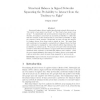Free Online Productivity Tools
i2Speak
i2Symbol
i2OCR
iTex2Img
iWeb2Print
iWeb2Shot
i2Type
iPdf2Split
iPdf2Merge
i2Bopomofo
i2Arabic
i2Style
i2Image
i2PDF
iLatex2Rtf
Sci2ools
SOCNET
2016
2016
Structural balance in signed networks: Separating the probability to interact from the tendency to fight
Structural balance theory implies hypothetical network effects such as “the enemy of an enemy is a friend” or “the friend of an enemy is an enemy.” To statistically test such hypotheses researchers often estimate whether, for instance, actors have an increased probability to collaborate with the enemies of their enemies and/or a decreased probability to fight the enemies of their enemies. Empirically it turns out that the support for balance theory from these tests is mixed at best. We argue that such results are not necessarily a contradiction to balance theory but that they could also be explained by other network effects that influence the probability to interact at all. We propose new and better interpretable models to assess structural balance in signed networks and illustrate their usefulness with networks of international alliances and conflicts. With the new operationalization the support for balance theory in international relations networks is much stronger than...
| Added | 09 Apr 2016 |
| Updated | 09 Apr 2016 |
| Type | Journal |
| Year | 2016 |
| Where | SOCNET |
| Authors | Jürgen Lerner |
Comments (0)

